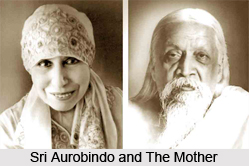 Sri Aurobindo Ashram is a spiritual community located in Puducherry. It is the main tourist attraction of Puducherry. The ashram grew out of a small community of disciples who had gathered around Sri Aurobindo after he retired from politics and settled in Puducherry in 1910.
Sri Aurobindo Ashram is a spiritual community located in Puducherry. It is the main tourist attraction of Puducherry. The ashram grew out of a small community of disciples who had gathered around Sri Aurobindo after he retired from politics and settled in Puducherry in 1910.
Foundation of Sri Aurobindo Ashram
Sri Aurobindo was a strong freedom fighter of the pre-Gandhian era. He came to Puducherry in 1910 following spiritual "Adesh" (voice or order). It was then a French territory where he remained for ever practicing Yoga. A French lady, Mirra Alfassa known as "the Mother" later joined him. Thereafter, the number of his followers increased and thus the Ashram was set up.
On 24th November 1926, after a major spiritual realization, Sri Aurobindo withdrew from public view in order to continue his spiritual work. At this time he handed over the full responsibility for the inner and outer lives of the "Sadhakas" and the ashram to his spiritual collaborator, "the Mother". This date is therefore generally known as the founding-day of the ashram.
 Aims and ideals of Sri Aurobindo Ashram
Aims and ideals of Sri Aurobindo Ashram
The Ashram, according to Sri Aurobindo, "has been created with another object than that ordinarily common to such institutions, not for the renunciation of the world but as a centre and a field of practice for the evolution of another kind and form of life which would in the final end be moved by a higher spiritual consciousness and embody a greater life of the spirit."
The complete method of Integral Yoga aims to transform human life into a divine life. In Sri Aurobindo"s yoga, the highest aim is the state of being one with the Divine, without the renunciation of life in the world. There must be "a general spiritual awakening and aspiration in mankind" as well as "a dynamic re-creating of individual manhood in the spiritual type".
Rules and Regulations of Sri Aurobindo Ashram
During the early years of the community Sri Aurobindo and the Mother imposed very few rules on the followers, because they wished them to learn to direct their lives by looking for the divine guidance within. The main rules were an absolute prohibition of alcohol, drugs, sex and politics. There were also a number of guidelines for the smooth functioning of the collective life of the community.
 Present Amenities of Sri Aurobindo Ashram
Present Amenities of Sri Aurobindo Ashram
Now, there are about 2000 inmates and Sadhakas practicing in action the integral or supra-mental yoga of Sri Aurobindo. Sri Aurobindo and the Mother"s Samadhis are enshrined in the main Ashram building. It is kept open to public from 8.00 a.m. to 5.00 p.m. with a break from 12.00 noon to 3 p.m. During some important days, which are observed in the Ashram, public are allowed to have darshan of Sri Aurobindo"s and the Mother"s rooms. On those days, thousands of devotees gather to have a glance.
Sri Aurobindo Ashram runs many educational institutions. They also run the gymnasia and the playground activities and organise the cultural programmes and exhibitions every now and then. The things used by Sri Aurobindo and a rare collection of beautiful artifacts can also be seen in the Ashram.
Publications at Sri Aurobindo Ashram
Sri Aurobindo Ashram is the primary publisher of the works of Sri Aurobindo and the Mother. The Ashram publishes a number of journals relating to the philosophy and yoga of Sri Aurobindo and the Mother. The books of Sri Aurobindo can be bought from the reception counter of the Ashram. The pictures, calendars and diaries related to Aurobindo and the Mother can be also availed from the Ashram.




















